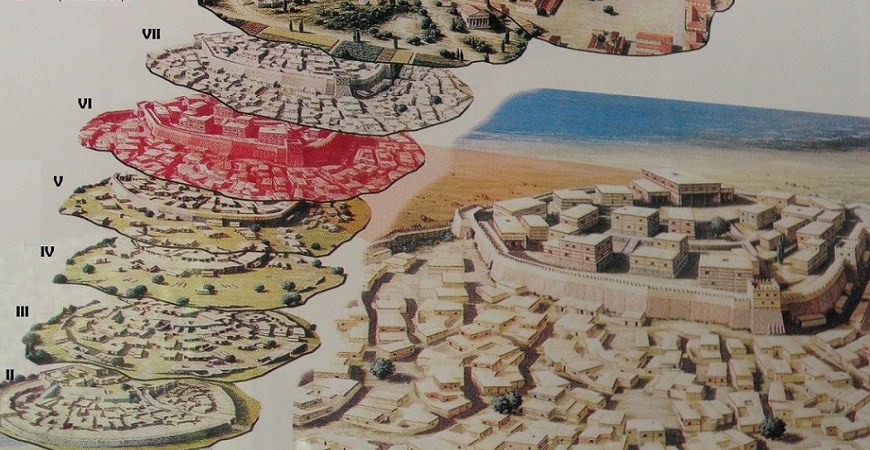Canakkale Troy Ancient City and Troy Museum,
Troy Ruins
At the entrance to the gallery are a map of Gallipoli Peninsular, bat plans, and war photographs. Against the wall are different-sized cannonballs.
The showcases in the gallery contain glass and ceramic Medici and drink bottles, and pitchers belonging to the French and English, flasks, lead bullets, bones of shrapnel, weapons with fixed bayonets other articles of war belonging to Turkish, French, and English soldiers. In the center of the gallery is a group of swords and revolvers bonding to Turkish officers; a group of Turkish, French and English machine guns, ammunition and rifle swords; and a collection of money taken fro the Turkish dead, foreign money and name inscriptions. There is also a display of articles used in the war, such as flints, forks, spoons etc., as Turkish, French and English buttons. On two tables at the edge of the wall are the watches of soldiers who were killed, jaw bones with false and gold filled teeth and medicine Behind, is a large oil painting depicting the sinking of the Bovet battleship In the showcase at the entrance are the seals and various medallion taken from the dead. You can take a look at our 1 Day & 1 Night Troy Tour From Istanbul.
Troy Museum
The city of Troy, which is located 32 km south of Canakkale, is known throughout the world. This ancient city was founded in 3000 BC and continued to be inhabited until the fourth century AD. Excavations carried out by Schliemann in 1868 uncovered 9 layers of ruins belonging to 9 different periods at the site and the Troy treasury. In 1890 the excavations were renewed and continued until 1938. At the entrance to the Troy ruins is a small museum which has recently been set up. The museum contains pottery, figurines, statues, glass objects and building stones found in the excavations at Troy and the surrounding region.
Camyayla Ataturk Museum:
The house in the village of Camyayla in the Canakkale subprovince of Eceabat, which the Great Ataturk used as the 19th Division Headquarter during the Canakkale War, was turned into a museum and opened to it public in 1973. The rooms of the two-story house, which include Ataturk study and bedroom, contain the original furnishings, nd is decorated with photographs and pictures.
Canakkale Martyrs Monument and War Museum:
The Martyrs Memorial was begun in 1954 and completed in 1958. It is in memory of those Turkish soldiers who fell in the Canakkale War of 1914 – 1915. The Memorial is 7.5 m. in width, 10 m. in length, and 41.70 m. in height. It rests on a four-footed base. The gallery on the ground floor of the Memorial was made into the Canakkale War Museum in 1972.



































































































































